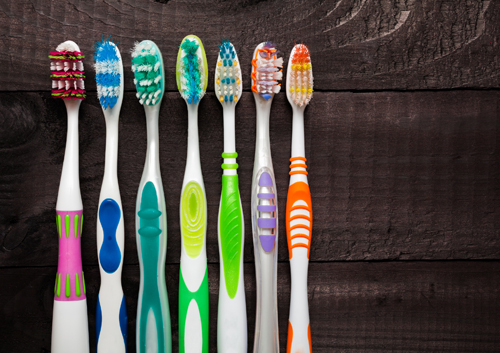March 13th, 2024

If you were to put your toothbrush bristles under a high-powered microscope, what you would see might give you nightmares: millions of bacteria, busily crawling up and down your toothbrush bristles, consuming proteins that came from your mouth, and still clinging to the bristles even after you’ve rinsed them with water.
Rinsing your toothbrush after brushing removes some of those ferociously hungry bacteria, but not all. The American Dental Association says that bacterial infestations develop on toothbrushes within a month of daily use. The ADA also states that unless a toothbrush is sterilized before being packaged, it’s going to come with bacteria – free of charge!
Germs and Frayed Bristles: the Demise of a Toothbrush
Dr. Adam Hoybjerg and our staff recommend that you toss your old toothbrush in the trash and purchase a new one every three months. Children tend to bite on their toothbrushes, which makes the bristles degrade and fray faster. Chances are kids may need to have their toothbrushes changed more frequently.
Where do they hide?
Bacteria are tenacious little germs that head for those concealed areas between toothbrush bristles. They are highly adaptable and exist in every type of extreme environment. Some people actually go so far as to put their toothbrush in a microwave for a few seconds to kill germs, but this doesn't always work either. In fact, you may only end up with a toothbrush that’s as bendable as a Gumby doll – and still covered with germs.
Feed a Cold, Starve a Fever, and Get Rid of Your Toothbrush
When you have a head cold, your mouth is teeming with bacteria gleefully roaming around, and gobbling mucus and dead skin cells. If you brush your teeth while suffering a sinus condition, the brush will act like a magnet for ravenous bacteria. Use your old toothbrush while you are sick, but as soon as you feel better, throw it away and get a new one. Otherwise you could possibly re-infect yourself with the same cold germs!
March 6th, 2024

If you’ve been hiding your smile because you have crooked teeth or gaps between your teeth, it’s time to consider orthodontic treatment with Dr. Adam Hoybjerg. Preparing for treatment is an important part of getting the smile you want.
Basic exams
The first step of preparation is the examination. An oral exam and X-rays taken at our office are necessary to identify potential problems and ensure the right steps are taken to prepare for orthodontic treatment at Hoybjerg Orthodontics.
Dr. Adam Hoybjerg will first examine your teeth and take X-rays to determine if it is necessary to extract any teeth or additional work is necessary before braces are possible. You will be prepared for the next step of treatment after your exam is complete and potential problems are identified.
Model for bite
The next step in preparing for orthodontic is taking a plaster model of the mouth. With the model, Dr. Adam Hoybjerg will be able to determine how the jaw is aligned so that appropriate adjustments can be made to the mouth and jaw with braces.
Depending on the situation, the model may be used to help evaluate your jaw and make decisions about appropriate treatment for your specific needs. Dr. Adam Hoybjerg can create a model of your mouth with the bite indentation that is taken during preparation.
Extracting teeth
If it is determined that a tooth extraction is necessary, then the final step of preparing for orthodontic treatment is the removal of teeth. Only Dr. Adam Hoybjerg can determine if it is necessary to remove any teeth before moving forward with the procedure to put on braces.
When your teeth are crooked, have a gap, or otherwise make you unhappy, orthodontic treatment at Hoybjerg Orthodontics may be an appropriate solution. Although it may take time to prepare for the actual procedure, making the decision to seek treatment can provide the opportunity to show the world a beautiful smile.
For more information about orthodontic treatment and its benefits, or to schedule a consultation with Dr. Adam Hoybjerg, please give us a call at our convenient Yuba City office!
February 28th, 2024

At our office, Dr. Adam Hoybjerg and our team do all that we can to make sure that your experience with us is the best it can possibly be. However, there’s an important role you play in this as well: leaving us reviews and feedback.
Whether there is something you’d like us to improve upon, or you’d just like to express your thanks for a job well done, your feedback is essential to our practice’s success.
We look forward to hearing from you, and are excited to hear what you thought of your most recent visit at our Yuba City office.
February 21st, 2024

Dr. Adam Hoybjerg and our team correct the alignment of your teeth and jaws so that you can speak clearly, chew food effectively, and look attractive when you smile. We do this by putting sophisticated gadgets in your mouth. While many of these dental devices look similar, we use a wide variety of orthodontic appliances to straighten your teeth and repair jaw problems.
Orthodontic appliances are devices that move your teeth, change the position of your jaw, or hold your teeth in their finished positions after your braces are removed. These devices may be attached to your teeth or removable.
Braces straighten your teeth. Brackets, bands, and wires characterize traditional braces. Braces are attached to the teeth, so they are not easily removable.
Spacers are small plastic rings fitted between your back teeth before your braces are placed by Dr. Adam Hoybjerg. These spacers create space between your teeth to optimize the alignment your braces provide.
Retainers hold teeth in their finished position after your braces come off. A Hawley retainer is the most common type of retainer; it features an acrylic plate that rests against the roof of your mouth and a wire crossing in front of your teeth. Essex retainers are quite popular, as they are durable and nearly invisible.
Bite plates correct a deep bite, where the upper front teeth come down too far over the lower front teeth to cause bite problems.
Holding arches prevent the back teeth from moving forward to crowd the front teeth. A lower lingual holding arch prevents your permanent molars from migrating forward. The Nance holding arch maintains space between teeth after you lose baby teeth and before the permanent teeth come in.
A palatal expander widens your upper jaw by separating the bones of your palate. This appliance helps your top and bottom teeth fit together better. The Quad Helix widens your jaws to create more room for crowded teeth.
Contact our Yuba City office today to learn more about the ways we can improve the appeal and function of your smile.





